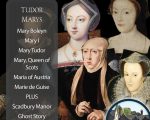
Happy New Year! This month in Tudor Life Magazine, we have a bumper edition which is 94 pages long. It’s all about the Marys who made up the Tudor world…
[Read More...]
Happy New Year! This month in Tudor Life Magazine, we have a bumper edition which is 94 pages long. It’s all about the Marys who made up the Tudor world…
[Read More...]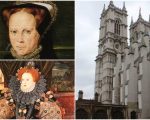
Thank you to Lynne for asking these two questions about the shared tomb of Queens Elizabeth I and Mary I: “Why did James I decide to bury Elizabeth I on top of her sister Mary? Why is Elizabeth I’s effigy visible with her mother’s coat of arms and nothing on display for Mary?”
Let me tell you about their burials and their present resting place at Westminster Abbey.
Queen Mary I, daughter of Henry VIII and his first wife, Catherine of Aragon, died on 17th November 1558. Mary left instructions in her will for her mother’s remains, which had been buried at Peterborough Abbey, to be exhumed and brought to London so that Catherine could be buried with Mary. However, her instructions were ignored; Catherine remained at Peterborough and Mary lay in state at St James’s Palace until her funeral on 14th December 1558, when she was buried at Westminster Abbey with just stones marking her resting place. You can read more about her funeral in my article 14 December 1558 – Burial of Queen Mary I.
[Read More...]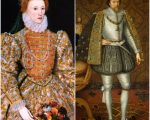
It is well known that when Elizabeth I died on 24 March 1603 at Richmond Palace, she was succeeded on the throne of England by her first cousin twice removed, James VI of Scotland. Although Elizabeth had consented to the execution of James’s mother, Mary, Queen of Scots, in 1587, the mainly cordial relations between the Scottish king and the English queen were undoubtedly influenced by James’s hope that he would eventually be named successor to Elizabeth. The Tudor queen had been notoriously reluctant during her forty-four-year reign to name a successor, but as her life drew to a close Elizabeth realised that the maintenance of peace in her kingdom depended greatly on a stable succession. The peaceful accession of James in the spring of 1603, however, has obscured the dynastic and political relevance of a forgotten noblewoman – Anne Stanley, later Countess of Castlehaven. In the twenty-first century, Anne is generally known not for her dynastic importance but for her testimony against her husband, which led to his execution for sodomy in 1631.
[Read More...]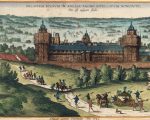
Thank you so much to Tudor Society member Nancy for asking this question: “If the queen had to make a pottie stop between residences, how would that be accomplished? Does anyone know?”
Social historian and re-enactor Bess Chilver has answered Nancy’s question, taking into account what a king would do as well. Over to Bess…
Very interesting question. Our perception of a Royal, even now in these times of minimal deference, is that of a figure, remote and almost not human. Or at least, not subject to the usual human frailties and bodily functions.
However, even a King or a Queen needs to use the (Royal) Potty sometimes, so where did they use it?
Within their own properties, there were rooms specifically for their own private use. The Close Stool or Privy was the Medieval and 16th-century versions of the modern toilet. Mostly they worked in a similar way to a modern composting toilet except that the contents of the toilet would be removed by the night soil men. The effluent would be used for composting elsewhere – an excellent example of recycling.
[Read More...]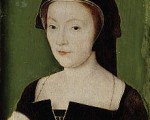
Thank you to Heather R. Darsie for this article on Mary of Guise (Marie de Guise), who was crowned Queen Consort of Scotland on this day in 1540.
Mary of Guise was born on 22 November 1515 to Claude of Lorraine, the Duke of Guise, and Antoinette of Bourbon. She was the eldest of twelve children. Mary was first made a wife in 1534 at the age of eighteen when she married the Duke of Longueville. She had two sons with her first husband, the second of whom died young. The Duke of Longueville passed away in 1537 when Mary was only twenty-one. She was then courted by both Henry VIII of England and James V of Scotland.
[Read More...]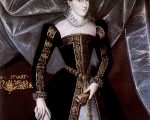
By 15 June 1567, twenty-four-year-old Mary Stuart had been Queen of Scotland for almost her entire life; never knew her father, James V, because he died when she was six days old; was Queen Consort, then Queen, of France for less than seventeen months; had lost her mother in July 1560; was about to celebrate her son and heir’s first birthday on 19 June, and was married to her third husband. Mary’s first husband, King Francis II of France, died three days before Mary’s eighteenth birthday in 1560. Mary’s mother was dead for roughly five months when her first husband died. She married her second husband, Henry Stuart, Lord Darnley, when she was twenty-two. Mary gave birth to her only surviving child, James VI, during her marriage to Darnley. Darnley died, likely murdered, less than two years after the marriage, and Mary married her third husband, James Hepburn, 4th Earl of Bothwell. Bothwell may have had a hand in the death of Mary’s second husband and there is speculation as to whether Mary indeed wanted to marry Bothwell or whether she was coerced into the marriage.
[Read More...]
Just to let you know that this programme is on at 9pm on Wednesday (10th February) on the UK’s BBC Four channel. Here’s the blurb:
“Vanessa Collingridge examines the life of Elizabeth Tudor, with particular interest in how documentary television and the BBC has examined her legacy….”
[Read More...]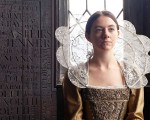
If you’re in the UK or have access to the UK’s BBC2 then make sure that you catch this programme on BBC2 today (1st February 2016) at 9pm. Here’s the blurb from the BBC:
[Read More...]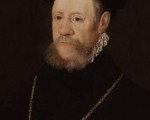
On 29th September 1553, Michaelmas or the Feast of St. Michael and All Angels, Mary I created fifteen1 Knights of the Bath as part of her coronation celebrations.
[Read More...]
Our December talk is by Linda Porter, author of “Crown of Thistles: The Fatal Inheritance of Mary, Queen of Scots”. In this talk, Linda looks at the lives of three queens of England – Katherine Parr, Mary I and Mary, Queen of Scots.
The live chat will be on Monday 15th December at 7:30pm UK Time (That’s 2:30pm Eastern time/11:30am Pacific time/8:30pm Central European Time).
[Read More...]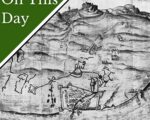
On this day in Tudor history, 7th May 1560, in the reign of Elizabeth I, English troops charged the wall of Leith at the siege of Leith.
In 1548, during the War of the Rough Wooing, which had broken out over Scotland’s refusal to marry Mary Queen of Scots off to Edward VI, Scotland had invited French troops to protect the port of Leith. They set up a garrison and were still there 12 years later. Protestant reformers turned to England to help them remove these French Catholics.
[Read More...]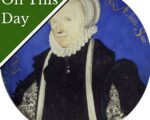
On this day in Tudor history, 19th February 1567, in the reign of Queen Elizabeth I, Margaret Douglas, Countess of Lennox, was informed of the murder of her son, Henry Stewart, Lord Darnley.
Darnley had been murdered nine days earlier at Kirk o’ Field, Edinburgh, in the Royal Mile, just a few hundred yards from Holyrood House where his wife, Mary Queen of Scots, and baby son, the future James VI/I, were staying.
[Read More...]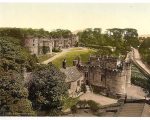
In my article on Margaret Clifford, Countess of Derby, I noted that Margaret has been neglected by historians and novelists alike. Both Margaret and her mother Eleanor Brandon, Countess of Cumberland, have been marginalised in both fiction and non-fiction, especially when compared with other royal women of the period such as Lady Jane Grey and her sisters, Lady Margaret Douglas and, of course, Henry VIII’s six wives. The academic and popular fascination with the Grey family is explicable in view of their dynastic importance during the reigns of Edward VI and Elizabeth I; during Edward’s reign, Jane Grey was named heiress to the throne and would have reigned as queen of England had it not been for the extraordinary success of Mary Tudor’s coup in the summer of 1553. Jane’s sister Katherine was widely regarded as a viable successor to Elizabeth I, which enraged and unnerved the Tudor queen. After clandestinely marrying Edward Seymour, Katherine was incarcerated in the Tower of London, her marriage declared invalid and her children deemed to be illegitimate. More recently, Lady Margaret Douglas has attracted the interest of historians and novelists; as the mother-in-law of Mary Queen of Scots and the grandmother of James I of Scotland, this interest is perhaps not surprising.
[Read More...]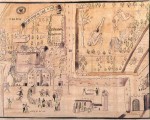
On this day in history, the 10th February 1567, Henry Stuart, Lord Darnley was murdered at Kirk o’ Field, Edinburgh, in the Royal Mile, just a few hundred yards from Holyrood House where his wife, Mary Queen of Scots, and baby son, the future James VI/I, were staying.
[Read More...]
On this day in history, 9th March 1566, David Rizzio (Riccio), the private secretary of Mary, Queen of Scots, was stabbed to death in front of a heavily pregnant Queen Mary.
But who was David Rizzio and what led to his murder?
John Guy, historian and author of the excellent “My Heart is My Own: The Life of Mary Queen of Scots”, describes David Rizzio as a “young Piedmontese valet and musician, who had arrived in the suite of the ambassador of the Duke of Savoy and stayed on as a bass in Mary’s choir”. Mary obviously took a liking to Rizzio because in late 1564 she chose him to replace her confidential secretary and decipherer, Augustine Raulet, who was a Guise retainer and the only person who Mary had trusted with a key to the box containing her personal papers. Raulet, for some reason, had lost her trust.
[Read More...]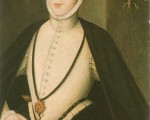
On this day in history, the 10th February 1567, Lord Darnley was murdered at Kirk o’ Field, Edinburgh, in the Royal Mile, just a few hundred yards from Holyrood House where his wife, Mary Queen of Scots, and baby son, the future James VI/I, were staying.
Henry, Lord Darnley, had been lodging at Kirk o’ Field while convalescing after contracting either syphilis or smallpox. What he didn’t know was that while he had been recovering his enemies had been filling the cellars of the house with gunpowder.
[Read More...]
On this day in Tudor history, 30th April 1596, Elizabethan lawyer, administrator and Speaker of the House of Commons, Sir John Puckering, died from apoplexy, a stroke, at the age of fifty-two. He was buried at Westminster Abbey in St Paul’s Chapel.
[Read More...]
On this day in history, 15th April 1623, Sir John Scudamore was buried at his home, Holme Lacy, following his death the previous day.
Scudamore served Elizabeth I as standard-bearer of the gentleman pensioners and his second wife, Mary Shelton, was related to the queen and was one of her ladies of the privy chamber.
Here are some facts about Sir John Scudamore:
[Read More...]
Thank you to author and historian Toni Mount for stopping by the Tudor Society on the book/blog tour for her new book, “The Colour of Bone”, the eleventh novel in the Seb Foxley medieval murder mystery series.
Toni has answered some interview questions…
[Read More...]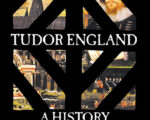

I first encountered Sir Anthony Standen while reading George Malcolm Thompson’s biography of Sir Francis Drake. “The time had come when Walsingham was no longer satisfied with news that came to him at second-hand, whether from Santa Cruz’s kitchen or from the Governor of Guernsey’s reports of the gossip on Breton ships or in Rouen taverns. He needed an accurate and detailed stream of information about the number of Philip’s ships, their tonnage, the sailors who would man them and the soldiers they would carry. Thanks above all to Standen, he got what he wanted.” Because my mother’s maiden name was Standen, I was immediately intrigued. Who was this man? Why hadn’t I heard of him before? Might he be an ancestor of mine?
[Read More...]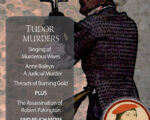
Tudor Murders – what an interesting theme we have for you in this month’s magazine. Murder is always a gruesome but fascinating topic and this magazine doesn’t disappoint
[Read More...]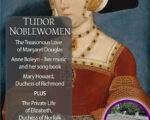
This month’s bumper-sized Tudor Life magazine is packed with articles about some of the interesting Tudor noblewomen.
[Read More...]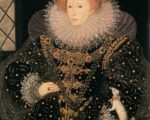


A warm welcome to Emma and Merel who are joining the Tudor Society team today for a 5-month apprenticeship as part of their Journalism degree. We are thrilled to have them on board and you might remember them from the Mary, Queen of Scots video they produced for us back in 2019 – see below.
Here are their bios…
[Read More...]
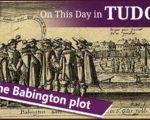
On this day in Tudor history, 20th September 1586, Anthony Babington, John Ballard, John Savage, Chidiock Tichborne and three other conspirators were executed near St Giles-in-the-Fields in London.
They suffered full traitors’ deaths, being hanged, drawn and quartered, after being found guilty of treason for plotting to assassinate Queen Elizabeth I in the famous Babington Plot, which sought to replace Elizabeth with Mary, Queen of Scots.
Find out more about Anthony Babington, the Babington Plot, the men involved, how it was discovered, and how it led to Mary, Queen of Scots’ execution, in today’s talk.
[Read More...]